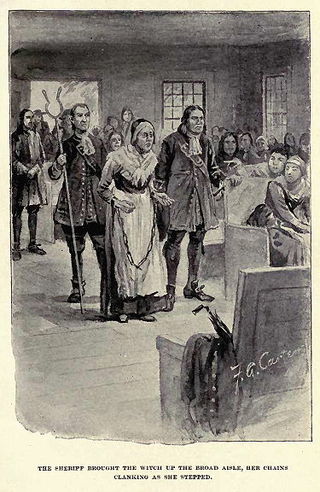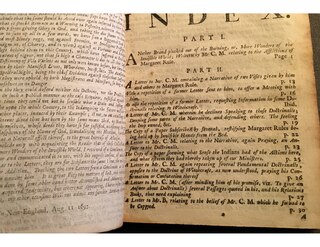
The Salem witch trials were a series of hearings and prosecutions of people accused of witchcraft in colonial Massachusetts between February 1692 and May 1693. More than 200 people were accused. Thirty people were found guilty, nineteen of whom were executed by hanging. One other man, Giles Corey, died under torture after refusing to enter a plea, and at least five people died in jail.
John Hathorne was a merchant and magistrate of the Massachusetts Bay Colony and Salem, Massachusetts. He is best known for his early and vocal role as one of the leading judges in the Salem witch trials.
John Proctor, Jr. was a landowner in the Massachusetts Bay Colony. He was the son of John Proctor Sr. (1594–1672) and Martha Harper (1607–1667). John and his 3rd wife were tried on August 5, 1692. He was hanged on August 19, 1692 in Salem Village, Massachusetts Bay Colony during the Salem Witch Trials after being falsely accused and convicted of witchcraft.
Elizabeth Proctor was convicted of witchcraft in the Salem Witch Trials of 1692. She was the wife of John Proctor, who was convicted and executed.

Samuel Parris was the Puritan minister in Salem Village, Massachusetts, during the Salem witch trials. He was also the father of one of the afflicted girls, and the uncle of another.

Tituba was a Native American enslaved woman who was one of the first to be accused of witchcraft during the Salem witch trials of 1692–1693.

Bridget Bishop was the first person executed for witchcraft during the Salem witch trials in 1692. Nineteen were hanged, and one, Giles Corey, was pressed to death. Altogether, about 200 people were tried.

George Burroughs was a non-ordained Puritan preacher who was the only minister executed for witchcraft during the course of the Salem witch trials. He is remembered especially for reciting the Lord's Prayer during his execution, something it was believed a witch could never do.

Sarah Good was one of the first three women to be accused of witchcraft in the Salem witch trials, which occurred in 1692 in colonial Massachusetts.

Martha Corey was accused and convicted of witchcraft during the Salem witch trials, on September 9, 1692, and was hanged on September 22, 1692. Her second husband, Giles Corey, was also accused and killed.

John Willard was one of the people executed for witchcraft in Salem, Massachusetts, during the Salem witch trials. He was hanged on Gallows Hill, Salem on August 19, 1692.

Rebecca Nurse was a woman who was accused of witchcraft and executed by hanging in New England during the Salem Witch Trials of 1692. She was fully exonerated fewer than twenty years later.

Cultural depictions of the Salem witch trials abound in art, literature and popular media in the United States, from the early 19th century to the present day. The literary and dramatic depictions are discussed in Marion Gibson's Witchcraft Myths in American Culture and see also Bernard Rosenthal's Salem Story: Reading the Witch Trials of 1692
This timeline of the Salem witch trials is a quick overview of the events.

Robert Calef was a cloth merchant in colonial Boston. He was the author of More Wonders of the Invisible World, a book composed throughout the mid-1690s denouncing the recent Salem witch trials of 1692–1693 and particularly examining the influential role played by Cotton Mather.
Rev. Nicholas Noyes II was a colonial minister during the time of the Salem witch trials. He was the second minister, called the "Teacher", to Rev. John Higginson. During the Salem witch trials, Rev. Noyes served as the official minister of the trials.
Deodat Lawson was a British American minister in Salem Village from 1684 to 1688 and is famous for a 10-page pamphlet describing the witchcraft accusations in the early spring of 1692. The pamphlet was billed as "collected by Deodat Lawson" and printed within the year in Boston, Massachusetts.
Sarah Cloys/Cloyce was among the many accused during Salem Witch Trials including two of her older sisters, Rebecca Nurse and Mary Eastey, who were both executed. Cloys/Cloyce was about 50-years-old at the time and was held without bail in cramped prisons for many months before her release.

Bray Wilkins was an immigrant, patriarch, and founder of Middleton, Massachusetts. Bray's origins are not concretely known and are supplanted by familial tradition, however his reputation was already prolific in the Massachusetts Bay Colony decades before his death. His progeny, the Wilkins family, had a strong presence in the area. Bray and his family were prominent figures in some Salem Witch Trials.











